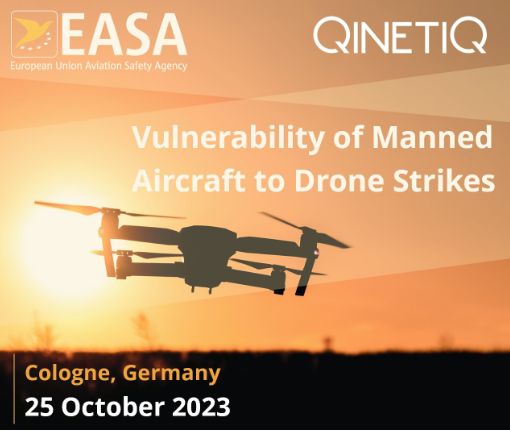The European Aviation Safety Agency (EASA) is presenting the results of the research work on ‘Vulnerability of manned aircraft to drone strikes’ at an on-site event on 25 October 2023. The project was funded by Horizon 2020, managed by EASA and implemented by QinetiQ.
EASA aims to complement the drone regulatory framework with full understanding the consequences of potential collision of drones with manned aircraft. Indeed, close encounters, mainly due to non-compliance with rules, still exist. When they occur in the vicinity of major airports, immediate consequence is traffic disruption with safety of commercial operations potentially at stake. It is essential to understand the collision phenomena and its potential consequences to inform future actions and ensure appropriate safety measures are in place.
This thread of actions started with the EASA drone collision task force, carried out in 2016, and continued within the EASA counter-UAS action plan. Following recommendations, EASA and the European Commission worked to establish an experimental project to provide proper scientific/technical basis for the understanding of the collision phenomena. The three-year project “Vulnerability of Manned Aircraft to Drone Strikes” was launched in June 2020 to provide such basis.
Background
Unmanned Aircraft Systems (UAS) operations are rapidly growing. EASA, in cooperation with the European Commission and with stakeholders, is ensuring their safe integration into the airspace by means of initiatives in several domains: regulatory, technical, social. The operation-centric regulatory framework for drones provides a portfolio of mitigation means, hinged on drone design, remote pilot skill, operator organization, operational limitations and services supporting the operation such to preserve adequate safety of drone operation. In particular, regarding the risk of drone collision with manned aircraft, key factor will be the establishment of U-space services, the fundamental pillars of which have been put in place with the adoption of the U-space regulation and the publication of related acceptable means of compliance (AMC).
(Image: Shutterstock)
For more information visit:




